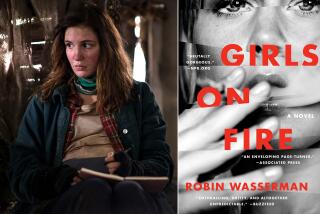The doctor you need to read
- Share via
With a wheeze and a clank, with a whir and a click and a screech of some sprockets and pulleys and belts, with a great belch of blue smoke and a blinding flash of light, the rocket ship takes off.
That’s how it generally happens in science-fiction movies, anyway. Your basic, garden-variety rocket ship is a noisy showoff that leaves no doubt about its intention to trample the laws of space and time into mealy mush.
But there’s an easier way. Flying faster than the speed of light is simple. All you need to do is pick up any one of the 44 books written and illustrated by Theodor Seuss Geisel (1904-91). Open it, read a few of those beautifully singsong lines, let your eyes rove over the contours of those kooky creatures he invented by the barrelful, and -- poof! -- you’re 6 years old again. Or 5 or 7 or 9, or whatever age you were when you first surrendered yourself to the lilting imaginative fecundity of the man who called himself “Dr. Seuss.”
Filmmakers perpetually try to piggyback on that Seuss magic; the latest attempt is “Horton Hears a Who!,” which has been flying high at the box office the last two weeks. I’ll let you judge the success of these attempts for yourself. What concerns us here is the Dr. Seuss oeuvre in its original incarnation -- in his books, that is, in those brightly colored and rapturously rhymed tales that take over the page with their mysterious wrigglings and their deeply satisfying sense of hope and fair play.
Pick up one today, as a grown-up, and -- Oh, the places you’ll go! You’ll be transported back to your childhood, lickety-split, back to a time when books and life weren’t separate entities -- with the book on one side, and the actual events of the world on the other -- but just one thing, a joyful whole, a splendid hunk, an unbroken talisman of fabulousness. Back in the day, there was no line between story and self. When you read about Whoville; you inhabited Whoville; you knew those Whovillians, and they knew you. You weren’t a tourist. You belonged. Belonging felt good.
And that is why, ultimately, there is a bit of sadness when you take the journey, when you let the narrative machine created by Dr. Seuss and his characters do its work. Because as an adult, you can never quite get all the way back. You can never again fully inhabit the Seussian universe, mind and soul, the way you could do so effortlessly when you were a kid. Adults know too much. We know too much for our own good. We’re too smart now. Too savvy. Too clever. We know that books are just books, that stories are only stories, that cats don’t typically cotton to headgear, that green eggs and ham would swiftly be recalled by the FDA, that elephants don’t actually save tiny civilizations that dwell in dust specks.
“Horton Hears a Who!” may, in the reliable way of a nifty rocket ship, whisk you back close to the place you were when you first marveled over the book -- but it cannot, alas, strip off the accumulated cynicism that sticks to all adults, constituting a second skin as tough as Horton’s hide. The wide-eyed kid who frolics in Whoville wouldn’t survive in a world of adjustable rate mortgages and credit card fraud and nasty presidential primary campaigns and seemingly endless wars. We wise up or we perish.
But maybe we can occasionally remind ourselves, with the brief and temporary shift of location that comes courtesy of the inimitable Geisel, of what it was like back there. Back in the land of Collapsible Frinks and Biffer-Baum Birds and tizzle-topped Tufted Mazurkas, up in the mountains of Zomba-ma-Tant or down on the plains of Motta-fa-Potta-fa-Pell, where the colors are bright, the creatures are real, and everything works out fine in the end.
More to Read
Sign up for our Book Club newsletter
Get the latest news, events and more from the Los Angeles Times Book Club, and help us get L.A. reading and talking.
You may occasionally receive promotional content from the Los Angeles Times.







